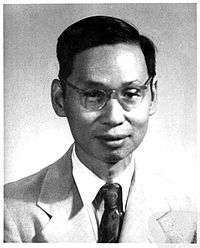Chung-Yao Chao

Chung-Yao Chao (simplified Chinese: 赵忠尧; traditional Chinese: 趙忠堯; pinyin: Zhào Zhōngyáo; Wade–Giles: Chao Chung-yao; 27 June 1902 – 28 May 1998) was a Chinese physicist. Chung-Yao Chao studied the scattering of gamma rays in lead by pair production in 1930, without knowing that positrons were involved in the anomalously high scattering cross-section. When the positron was discovered by Carl David Anderson in 1932, confirming the existence of Paul Dirac's "antimatter", it became clear that positrons could explain Chung-Yao Chao's earlier experiments, with the gamma rays being emitted from electron-positron annihilation.
He entered Nanjing Higher Normal School (later renamed National Southeastern University, National Central University and Nanjing University), in 1920 and earned a B.S. in physics in 1925. Then he earned a Ph.D. degree in physics under supervision of Nobel Prize laureate Robert Andrews Millikan at California Institute of Technology in 1930. Later he went back to China and joined the physics faculty of Tsinghua University in Beijing.
See also
Further reading
- Wang, Zuoyue (1970–80). "Zhao Zhongyao". Dictionary of Scientific Biography. 25. New York: Charles Scribner's Sons. pp. 397–402. ISBN 978-0-684-10114-9.